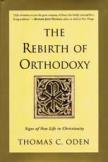When Led by the Spirit?
In a period of cultural and religious change, this book detects a revival of orthodoxy that offers a solution to the current religious turmoil. Oden divides his treatment into two parts. The first, entitled “The Gift of New Life,” deals with the present spiritual crisis in Christianity and the emergence of a new orthodoxy. He argues that rootlessness is the main cause of the current problems Christians face and that a recovery of ancient wisdom, rather than change, is the way to solve them. He describes orthodoxy as nothing more or less than the ancient consensual tradition of Spirit-guided discernment of Scripture. This universal agreement, which expresses itself in traditional spiritual practices such as reading the Scriptures, prayer, ritual, doctrinal integrity and moral accountability, can be observed across demominational Christian boundaries and has its counterpart in Jewish communities.
The indictment of the modern ecumenical movement is one of the more negative features of this book. Oden has nothing positive to say about the World Council of Churches and the National Council of Churches, which are depicted as ultra-liberal, modernist and characterized by revolutionary pretenses, whatever this means. He draws up an impressive chart comparing the old ecumenism (that of the W.C.C.) with the new and states that the former has damaged the cause of Christian unity. This hardly does justice to many successful efforts of the W.C.C. to further mutual understanding and reduce conflict between the various Christian churches and different faith traditions. The reader is left with the impression that for the author, Christian unity ultimately consists in accepting the orthodoxy he so passionately advocates. In another chapter, which explains why orthodoxy has persisted and is experiencing a revival, the main reasons he gives can be probably reduced to one—namely, that the new orthodoxy is guided by the Holy Spirit. One can hardly miss the insinuation that anything that happened since the fourth and fifth centuries that does not fit into his view of orthodoxy is not guided by the Spirit. It is not surprising that the author fails to take into account the social and psychological dynamics that play an important role in the rise of fundamentalist movements, including the one he endorses.
The second part of the book, “Signs of New Life,” describes in some detail evidence of this recovery of orthodoxy. Here Oden deals with six areas: personal transformation, which shows how a return to orthodoxy has transformed the lives of many people; faithful scriptural interpretation, which refers to the efforts to recover the earliest Christian interpretation of Scripture; ancient ecumenical multiculturalism; well-established secure boundaries “between orthodoxy and heresy”; ecumenical roots reclaimed; and consensual ecumenical discernment.
The author, however, fails to mention the spiritual renewal of many Christians who have not returned to the orthodoxy he champions. He indirectly rejects most of the scriptural studies done since the late 19th century, studies that have increased not only our understanding of the good news but also nourished the faith of many. He further contends that the classical ecumenical method of consensus fidelium elaborated by Vincent of Lérins in the fifth century will solve the current divisions among Christians in the 21st century. He does not show, however, how the orthodoxy he is promoting can further Christian unity; it certainly did not do so in the early church. His contention that the new orthodoxy calls for a more radical diversity, inclusion and tolerance does not square with the fact that Christian movements that claim they are the only legitimate expression of true Christianity have tended to be intolerant and belligerent, as recent studies of fundamentalism have shown.
This book obviously advances a Christian conservative and fundamentalist agenda, even though the author does not explicitly acknowledge it. It encourages us to return to an earlier form of a unified Christianity but neglects to mention that doctrinal conflicts and divisions have been with the church since long before the modern era. It presents a static view of Christianity and, the author’s views notwithstanding, leaves us with a Christianity too tied down to a specific historical and cultural period. It offers no guidelines as to how the church can react to technology and globalization, except maybe to retreat into the presumed safety and security of the conciliar age. In spite of his insistence that the new orthodoxy is multicultural, there is no evidence that he is willing to consider African and Asian forms of Christianity that can be expressed in cultural molds different from those of the fourth and fifth centuries. His analysis provides no theological reflections at all on the growing religious pluralism and on the need to stress social justice. The future of a faith that can respond to modern developments and challenges only by harking to an idyllic past cannot be very promising.
This article also appeared in print, under the headline “When Led by the Spirit?,” in the April 28, 2003, issue.








